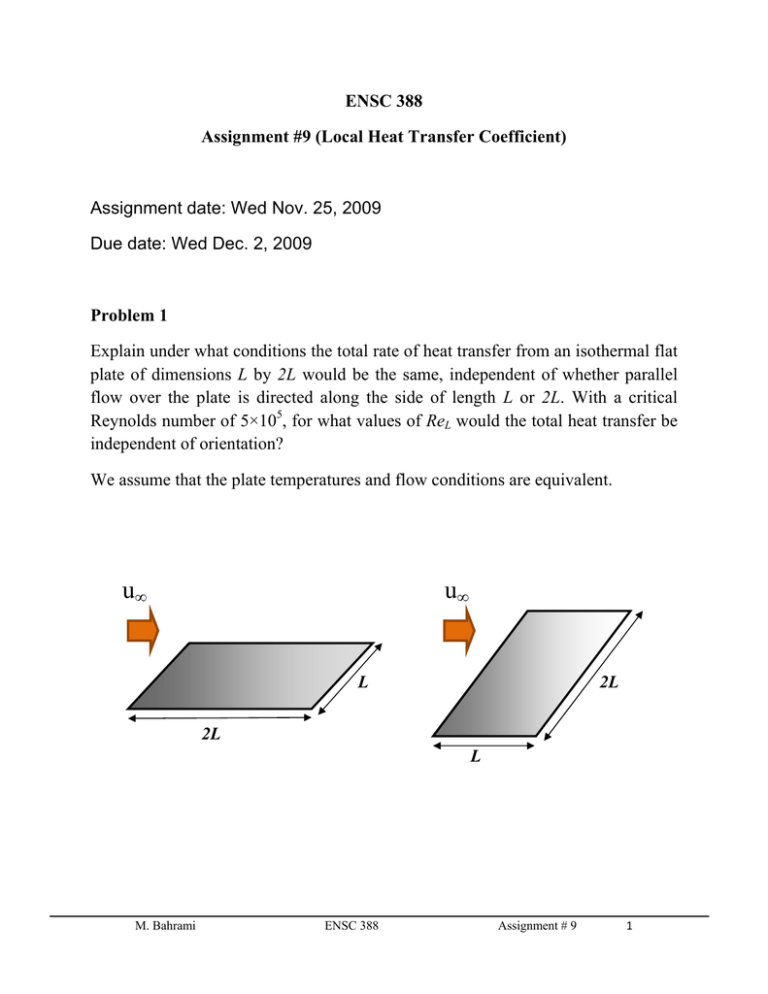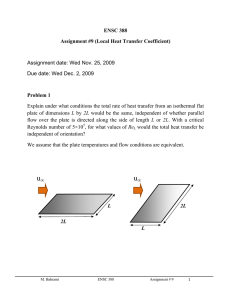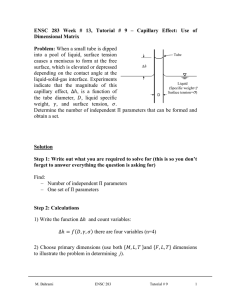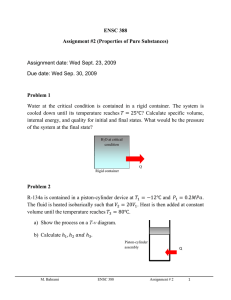ENSC 388 Assignment #9 (Local Heat Transfer Coefficient) Problem 1
advertisement

ENSC 388 Assignment #9 (Local Heat Transfer Coefficient) Assignment date: Wed Nov. 25, 2009 Due date: Wed Dec. 2, 2009 Problem 1 Explain under what conditions the total rate of heat transfer from an isothermal flat plate of dimensions L by 2L would be the same, independent of whether parallel flow over the plate is directed along the side of length L or 2L. With a critical Reynolds number of 5×105, for what values of ReL would the total heat transfer be independent of orientation? We assume that the plate temperatures and flow conditions are equivalent. u∞ u∞ L 2L 2L L M. Bahrami ENSC 388 Assignment # 9 1 Problem 2 The surface of a 1.5 m long flat plate is maintained at 50◦C and water at a temperature of 4◦C and a velocity of 0.6 m/s flows over the surface. Determine: a) The heat transfer rate per unit width of the plate in W/m. b) If a wire were placed near the leading edge of the plate (to induce turbulence), what would be the heat transfer rate? Water T∞ = 4˚C u∞ = 0.6 m/s ′′ Ts = 50˚C L=1.5 m M. Bahrami ENSC 388 Assignment # 9 2 Problem 1: Known: - Flow regime - Size and oriantation of plates - Isothermal plates Find: - ReL number for which the total heat transfer is independent of orientation. Assumptions: - Steady state - Costant properties Analysis: The total heat transfer rate would be the same (qL = q2L), if the convection coefficients were equal, hL = h2L. Conditions for which such an equality is possible may be inferred from a sketch of hL versus ReL . hL Rex,cr ReL,b ReL,a 5x105 Re2L,a Re2L,b ReL M. Bahrami ENSC 388 Assignment # 9 3 L−1/2. Similiarly, for mixed For laminar flow ReL < Rex,cr, it follows that the hL laminar and turbulent flow hL = C1L−1/5 − C2L−1 for ReL > Rex,cr and hL will vary with ReL as shown above. Therefore, two possibilities are suggested: Case a): Laminar flow exists on the shorter plate, while mixed flow conditions exist on the longer plate. Case b): Mixed boundary layer conditions exist on both plates. In both cases, it is required that hL = h2L and Re2L = 2ReL Case a): From expression for hL in laminar and mixed flow / 0.664 / 2 / 0.664 / 0.037 / 0.032 / 871 435 Since ReL < 5×105 and Re2L = 2ReL > 5×105, the required value of ReL may be narrowed to the range 2.5 × 105 < ReL < 5 × 105. From a trial and error solution, it follows that ReL ≈ 3.2 × 105 Case b): For mixed flow on both plates 0.037 / 0.037 871 / / 2 871 0.032 1.5 / 0.037 / 871 / 435 10 Note that it is impossible to satisfy the requirement that hL = h2L if ReL < 2.5×105 (laminar flow for both plates). Also the results are independent of the nature of the fluid. M. Bahrami ENSC 388 Assignment # 9 4 Problem 2: Known: - Surface length - Size and oriantation of plates - Flow condition Find: - The heat transfer rate per unit width of the plate. - heat transfer rate if a wire were placed near the leading edge of the plate Assumptions: - Steady state - Costant properties Analysis: The film temperature is 2 27 Using Table A-7, the propoerties of water canbe found as ρ = 997 υ = 0.86 × 10−6 k = 0.608 Pr = 5.88 M. Bahrami ENSC 388 Assignment # 9 5 a) First we must calculate the Reynolds number 1.046 10 Therefore, the flow is mixed and the appropriate correlation is: / 0.037 / 871 2797.6 1133.9 Thus, the heat transfer rate is 52.163 b) if the flow were tripped at the leading edge, the flow would be turbulent over the entire length of the plate, in that case, we must use the correlation for turbulent regime: 0.037 / / 4368.0 1770.5 Therfore, 81.443 M. Bahrami ENSC 388 Assignment # 9 6



